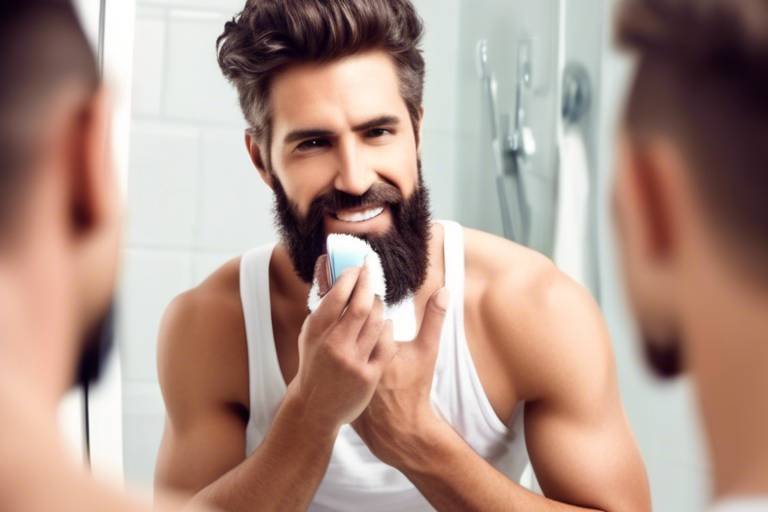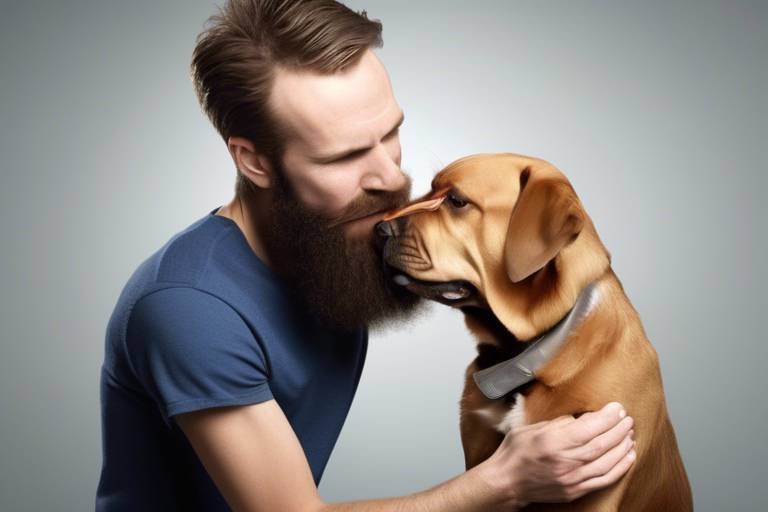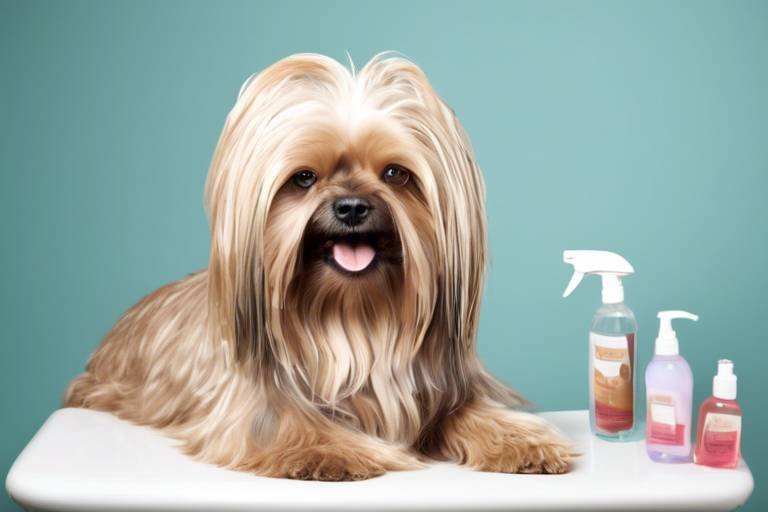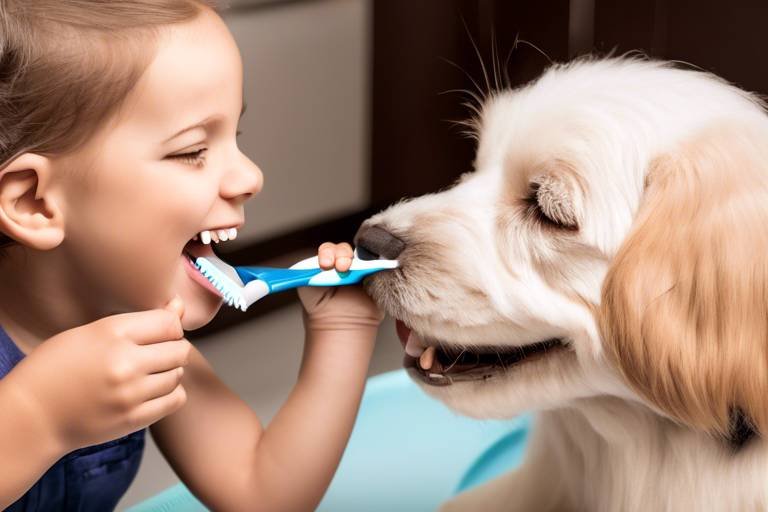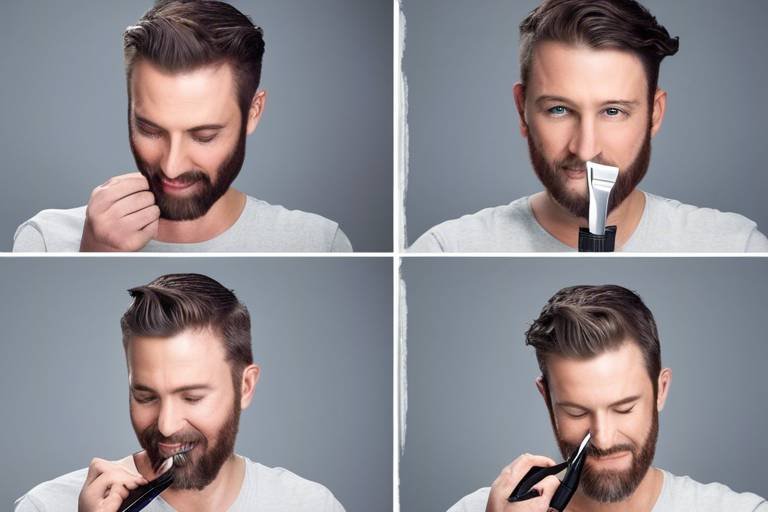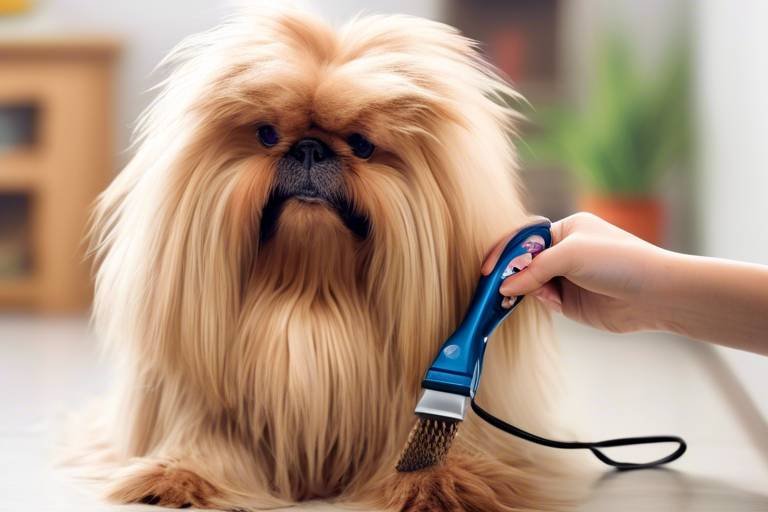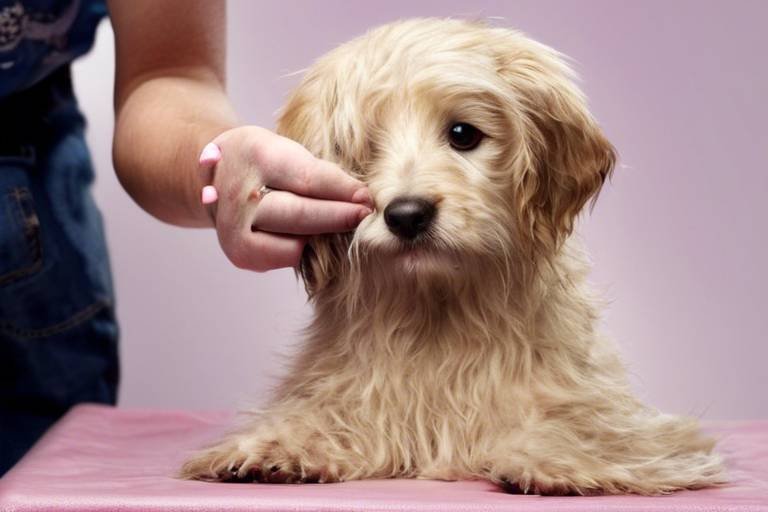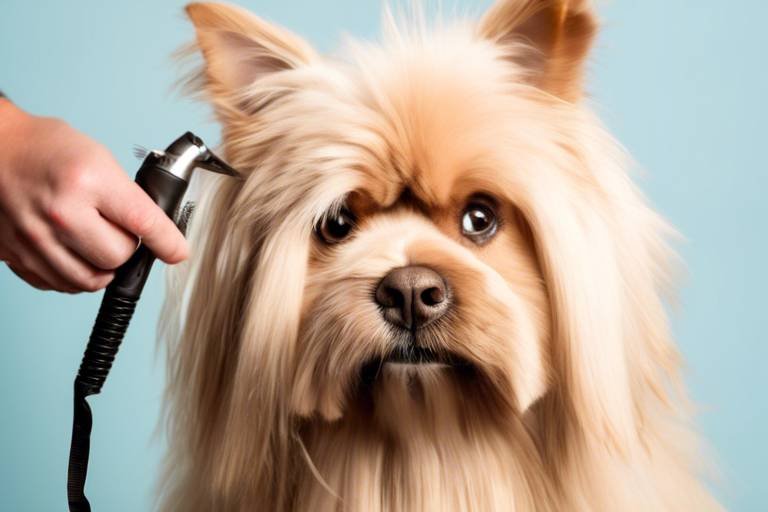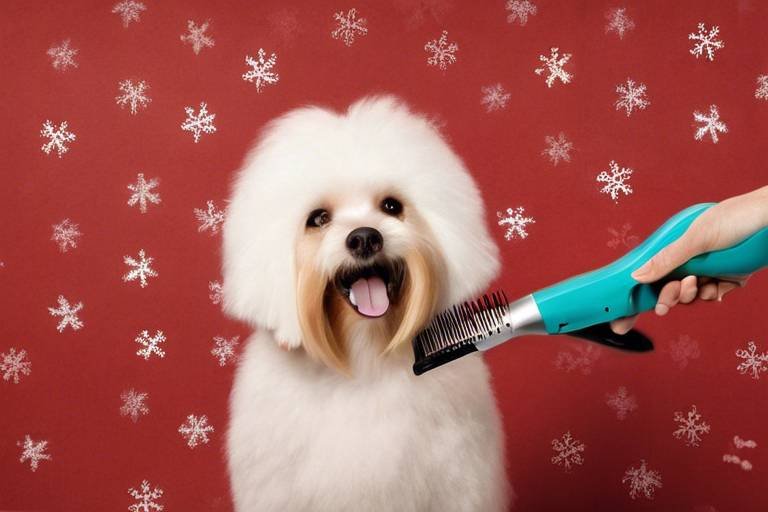The Best Practices for Maintaining a Clean Grooming Area
Maintaining a clean grooming area is not just about aesthetics; it’s a crucial part of ensuring the health and safety of both pets and groomers. Imagine walking into a grooming salon that sparkles with cleanliness, where every tool is in its place, and the air is fresh. This environment not only makes the grooming process more enjoyable but also reduces the risk of infections and illnesses that can arise from a dirty workspace. In this article, we will explore essential practices to ensure a clean and hygienic grooming area, emphasizing the importance of cleanliness for both pets and groomers in maintaining health and safety.
Why is cleanliness so vital in a grooming area? Well, think of it as the foundation of a healthy relationship between pets and their groomers. A clean grooming area acts as a barrier against bacteria, viruses, and parasites that could harm our furry friends. It’s not just about looking good; it’s about creating a safe haven where pets can feel comfortable and secure. When the grooming space is kept clean, it fosters a healthy environment that promotes the well-being of both animals and groomers. In fact, studies have shown that a clean grooming area can significantly reduce stress levels in pets, making the grooming experience more pleasant for everyone involved.
Establishing a daily cleaning routine is like brushing your teeth – it’s essential for maintaining hygiene! Every day, groomers should sweep the floors to remove hair and debris, disinfect surfaces, and ensure that all tools are sanitized after each use. This prevents cross-contamination and keeps the grooming area looking pristine. Consider creating a checklist to help you stay on track with your daily cleaning tasks. This could include:
- Sweeping and mopping the floors
- Wiping down tables and grooming stations
- Sanitizing grooming tools after each use
Regular sanitization of grooming tools is crucial in keeping pets safe from infections. Brushes, clippers, and scissors can harbor dirt and bacteria if not cleaned properly. To ensure your tools remain in top condition, follow these effective methods for cleaning:
- Brushes: Remove hair and debris, then wash with warm, soapy water. Rinse thoroughly and let them air dry.
- Clippers: Disassemble the blades and clean them with a clipper blade wash. Oil them regularly to keep them functioning smoothly.
- Scissors: Wipe down with disinfectant wipes after each use and sharpen regularly to maintain their effectiveness.
Selecting appropriate cleaning products is essential. Not all cleaning agents are safe for pets, so it’s vital to opt for pet-safe disinfectants that effectively eliminate germs without harming animals or leaving harmful residues. Look for products that are approved by veterinary professionals, ensuring they are both effective and safe for your furry clients.
Storing grooming tools correctly is equally important for maintaining cleanliness. Use designated containers to keep your tools organized and easily accessible. This not only prevents contamination but also helps in locating tools quickly during grooming sessions. Consider labeling storage bins to streamline the process further. A well-organized grooming area is like a well-tuned orchestra – everything works harmoniously together!
A clutter-free environment promotes efficiency and safety. When your grooming area is organized, you minimize distractions and reduce the risk of accidents. Invest in storage solutions like shelves, bins, and carts to keep your tools and supplies tidy. Regularly assess your workspace to remove any unnecessary items that could contribute to clutter. Remember, a clean space leads to a clear mind, allowing you to focus on what truly matters – providing the best care for your pets.
In addition to daily cleaning, regular deep cleaning is necessary to ensure maximum hygiene. This involves thoroughly cleaning all surfaces, equipment, and the overall grooming space. Schedule deep cleaning sessions weekly or monthly, depending on the volume of work and the number of pets you groom. During these sessions, pay special attention to areas that may be overlooked during daily cleaning, such as corners, under equipment, and behind storage units.
Establish a consistent schedule for deep cleaning sessions. Consistency is key in maintaining a pristine grooming area. You could mark these sessions on a calendar or set reminders on your phone to ensure they’re not overlooked. Involve your staff in these sessions to foster a team effort towards cleanliness.
Engaging staff in cleanliness practices fosters a team environment and ensures everyone is on the same page regarding hygiene standards. Train employees on the importance of maintaining cleanliness and involve them in the cleaning process. This not only boosts morale but also instills a sense of pride in the grooming space.
Regularly monitoring the cleanliness of your grooming area is essential. Implement checklists and assessments to ensure all cleanliness standards are met consistently. Consider conducting surprise inspections to keep everyone accountable. A clean grooming area is a reflection of your commitment to the health and safety of pets, so make it a priority!
Q: How often should I clean my grooming tools?
A: It’s recommended to sanitize your grooming tools after each use to prevent cross-contamination.
Q: Are there specific cleaning products that are safe for pets?
A: Yes, always opt for pet-safe disinfectants that are effective in eliminating germs without harming animals.
Q: How can I involve my staff in maintaining cleanliness?
A: Train your staff on hygiene practices and create a cleaning schedule that includes everyone’s participation.

Understanding the Importance of Cleanliness
When it comes to grooming our beloved pets, cleanliness is not just a matter of aesthetics; it's a crucial aspect of health and safety. Imagine walking into a grooming area that smells fresh, looks spotless, and feels welcoming. That’s the kind of environment that not only puts pet owners at ease but also enhances the overall experience for the pets themselves. A clean grooming area significantly reduces the risk of infections and illnesses, which can easily spread in a dirty environment. For both the pets and the groomers, cleanliness is synonymous with well-being.
Consider this: just like humans, pets can be susceptible to various skin infections and parasites, many of which thrive in unclean conditions. Regularly cleaning and sanitizing the grooming area helps to eliminate these threats. By maintaining a hygienic space, you are actively contributing to the health of your furry clients and ensuring that they leave the grooming salon looking fabulous and feeling great.
Moreover, a tidy grooming area promotes efficiency. When everything is in its place, groomers can work faster and more effectively, leading to happier pets and satisfied owners. It’s like having a well-oiled machine; when all parts function smoothly, the results are exceptional. This is why establishing a culture of cleanliness within the grooming environment is essential. Not only does it protect the animals, but it also showcases professionalism and care, which can significantly enhance your business's reputation.
In conclusion, the importance of cleanliness in a grooming area cannot be overstated. It is the foundation upon which a successful grooming operation is built. By prioritizing hygiene, you are safeguarding the health of the pets, ensuring the safety of the groomers, and creating a pleasant atmosphere for everyone involved. So, let’s dive deeper into the best practices for maintaining a clean grooming area, because a clean space is a happy space!

Daily Cleaning Routines
Establishing a daily cleaning routine in your grooming area is not just a good practice; it's a necessity. Think of it as the foundation of a well-oiled machine. Just like a car needs regular oil changes to run smoothly, your grooming space requires daily attention to function at its best. A clean environment not only enhances the aesthetics of your workspace but also significantly reduces the risk of infections and illnesses in pets. After all, a tidy area reflects professionalism and care, which pet owners will surely notice.
So, what does a solid daily cleaning routine look like? First and foremost, start each day by sweeping the floors. This simple act can remove hair, dirt, and debris that accumulate overnight. It’s like giving your grooming area a fresh start every morning! Following that, disinfect all surfaces that pets come into contact with, including tables, cages, and grooming stations. A quick wipe-down with a pet-safe disinfectant will do wonders in killing off any lingering germs. Make sure to pay special attention to high-touch areas where bacteria can thrive.
Another critical aspect of your daily routine should be the sanitization of your tools. Grooming tools such as brushes, clippers, and scissors can harbor dirt and bacteria if not cleaned properly. After each use, take a few minutes to clean and disinfect these tools. This will not only keep your equipment in tip-top shape but also ensure that your furry clients remain safe from potential infections. Remember, a few extra minutes spent cleaning today can save you from a world of trouble tomorrow!
For a more structured approach, consider creating a cleaning checklist. This can help you stay organized and ensure that no area is overlooked. Here’s a simple example:
| Task | Frequency |
|---|---|
| Sweep floors | Daily |
| Disinfect surfaces | Daily |
| Sanitize tools | After each use |
| Check and replace supplies | Daily |
In addition to these tasks, regularly check your supplies such as shampoos, conditioners, and cleaning products. Running out of essential items can disrupt your workflow and lead to a less-than-ideal grooming experience for your pets. By keeping everything stocked and organized, you’ll ensure that your grooming area remains efficient and effective.
Lastly, don’t forget to involve your team in the cleaning process. If you work with other groomers or staff, make it a point to assign specific cleaning tasks to each person. This not only fosters teamwork but also creates a sense of shared responsibility for maintaining a clean environment. Remember, a clean grooming area is a happy grooming area!
Q: How often should I clean my grooming tools?
A: You should sanitize your grooming tools after each use to prevent the spread of bacteria and maintain hygiene.
Q: What cleaning products are safe for pets?
A: Look for pet-safe disinfectants that are specifically designed to eliminate germs without harming animals or leaving toxic residues.
Q: Is it necessary to have a cleaning checklist?
A: Yes! A cleaning checklist helps ensure that no task is overlooked and keeps your grooming area consistently clean and organized.
Q: How can I involve my staff in maintaining cleanliness?
A: Train your staff on the importance of hygiene and assign them specific cleaning tasks to foster a team environment.
Sanitizing Tools and Equipment
When it comes to grooming, the **importance of sanitizing tools and equipment** cannot be overstated. Just like a chef wouldn’t cook with dirty pots and pans, a groomer should never work with unclean tools. Imagine the chaos that could ensue if bacteria were to spread from one pet to another! Regular sanitization not only protects the pets but also ensures the groomer’s safety. So, how do we keep our tools in tip-top shape? Here’s a breakdown of effective methods that can make all the difference.
First and foremost, it’s essential to establish a routine for cleaning your grooming tools. After each use, take a moment to brush off any hair and debris from your brushes and clippers. This quick step can prevent the buildup of dirt and grime that can harbor germs. Next, you should wash the tools with warm, soapy water. This is especially important for brushes and combs, which can trap dirt and oils. After washing, rinse them thoroughly and let them air dry. It’s a simple yet effective way to keep them clean!
Now, let’s talk about disinfecting. While soap and water are great, they don’t always get rid of all the nasties. That’s where a good **pet-safe disinfectant** comes into play. Choose a disinfectant that is specifically designed for grooming tools, ensuring it’s safe for pets and won’t leave harmful residues. Here’s a quick guide on how to disinfect your tools:
| Tool | Cleaning Method | Disinfectant Type |
|---|---|---|
| Brushes | Wash with warm, soapy water | Pet-safe disinfectant spray |
| Clippers | Wipe down with a cloth | Clipper disinfectant solution |
| Scissors | Clean with alcohol wipes | Pet-safe disinfectant |
Another critical aspect of maintaining clean tools is proper storage. After sanitizing, ensure that your tools are stored in a clean, dry place. Use designated containers for each type of tool to avoid cross-contamination. For instance, you might want to have a separate container for brushes and another for clippers. This organizational strategy not only keeps your workspace tidy but also prevents the mixing of dirty and clean tools.
Lastly, don’t forget to **regularly check your tools** for any signs of wear and tear. Dull scissors or worn-out clippers can not only be ineffective but can also cause injury to the pets. Keeping your tools in excellent condition is just as important as cleaning them. So, take the time to sharpen, replace, or repair tools as needed. By doing this, you’re ensuring a safe and effective grooming experience for both yourself and the pets in your care.
Choosing the Right Cleaning Products
This article explores essential practices to ensure a clean and hygienic grooming area, emphasizing the importance of cleanliness for both pets and groomers in maintaining health and safety.
A clean grooming area is vital for preventing infections and ensuring the safety of pets. It fosters a healthy environment that promotes the well-being of both animals and groomers.
Establishing a daily cleaning routine helps maintain hygiene. This includes sweeping, disinfecting surfaces, and ensuring all tools are sanitized after each use to prevent cross-contamination.
Regular sanitization of grooming tools is crucial. Learn effective methods for cleaning brushes, clippers, and scissors to ensure they remain free from dirt and bacteria.
When it comes to maintaining a clean grooming area, is absolutely essential. It’s not just about picking up any bottle off the shelf; you need to be mindful of the ingredients and their impact on both pets and the environment. Look for pet-safe disinfectants that effectively eliminate germs without causing harm to your furry clients. This means avoiding harsh chemicals that could leave harmful residues or irritate your pet's skin.
One effective strategy is to read labels carefully. You should look for products that are labeled as non-toxic, biodegradable, and eco-friendly. These products are generally safer for both pets and the environment. Additionally, consider using cleaning products that have been specifically formulated for grooming areas. These products often contain ingredients that not only disinfect but also deodorize, leaving your grooming space smelling fresh and clean.
Moreover, it’s wise to have a variety of cleaning products on hand to tackle different surfaces and situations. For instance, you might need:
- Surface cleaners: Ideal for countertops and grooming tables.
- Floor disinfectants: Essential for keeping the floor area free from bacteria and odors.
- Tool sanitizers: Specifically designed for brushes, clippers, and scissors.
Finally, don’t forget to involve your staff in the decision-making process. After all, they will be the ones using these products daily. Getting their input can help ensure that everyone is comfortable with the cleaning protocols and products being used in the grooming area.
Storing grooming tools correctly is important for maintaining cleanliness. Use designated containers and ensure tools are organized to prevent contamination and loss.
A clutter-free environment promotes efficiency and safety. Explore strategies for organizing your grooming area to minimize distractions and maintain a clean workspace.
In addition to daily cleaning, regular deep cleaning is necessary. This involves thorough cleaning of all surfaces, equipment, and the overall grooming space to ensure maximum hygiene.
Establish a schedule for deep cleaning sessions. Consistency is key in maintaining a pristine grooming area, so plan these sessions weekly or monthly.
Engaging staff in cleanliness practices fosters a team environment. Train employees on the importance of maintaining hygiene and involve them in the cleaning process.
Regularly monitoring the cleanliness of your grooming area is essential. Implement checklists and assessments to ensure all cleanliness standards are met consistently.
Q: How often should I clean my grooming area?
A: It’s best to establish a daily cleaning routine, along with regular deep cleaning sessions weekly or monthly.
Q: Are there specific cleaning products I should avoid?
A: Yes, avoid harsh chemicals that can irritate pets. Always choose pet-safe and eco-friendly products.
Q: How can I involve my staff in maintaining cleanliness?
A: Train them on the importance of hygiene and include them in the cleaning process to foster a team environment.
Proper Storage of Tools
When it comes to grooming, is not just about keeping your workspace tidy; it’s about ensuring safety and hygiene for both pets and groomers. Imagine stepping into a grooming area where scissors, clippers, and brushes are scattered everywhere. It’s not only chaotic but also poses a risk of injury and contamination. To avoid such scenarios, it’s crucial to have a dedicated space for each tool. This way, you’ll not only find what you need quickly but also minimize the risk of cross-contamination.
One effective method for organizing your grooming tools is to use designated containers. These can be anything from drawers to caddies that are specifically meant for grooming supplies. For instance, you might have a container for clippers, another for brushes, and a separate one for scissors. By categorizing your tools, you can maintain order and ensure that each item is easily accessible when you need it. Additionally, labeling these containers can save you precious time during busy grooming sessions.
Furthermore, consider implementing a cleaning routine for your storage areas. Dust and hair can accumulate in storage spaces, which can lead to hygiene issues. Regularly cleaning these areas not only keeps your tools in top condition but also reinforces the importance of cleanliness in the grooming process. For example, after each grooming session, take a few minutes to wipe down the surfaces where your tools are stored. This small effort can make a big difference in maintaining a hygienic environment.
Lastly, it’s essential to educate your team on the importance of proper tool storage. Encourage them to return tools to their designated places after each use. This not only helps in keeping the grooming area organized but also instills a sense of responsibility and teamwork among staff members. When everyone is on the same page, it fosters a culture of cleanliness that benefits both the pets and the groomers.
- Why is proper storage of grooming tools important? Proper storage prevents cross-contamination and ensures that tools remain in good condition, promoting a safer grooming environment.
- How often should I clean my grooming tools? It’s advisable to clean your tools after each use and perform a deeper clean weekly to maintain hygiene.
- What types of containers are best for storing grooming tools? Use containers that are easy to clean and organize, such as plastic caddies, drawer organizers, or toolboxes specifically designed for grooming supplies.
- Can I use regular cleaning products on grooming tools? No, always opt for pet-safe cleaning products to ensure the safety of the animals you are grooming.
Maintaining a Clutter-Free Space
When it comes to grooming, a clutter-free space isn’t just a luxury; it’s a necessity. Imagine trying to work in a chaotic environment where tools are strewn about, hair is everywhere, and you can’t find that important pair of scissors. Frustrating, right? A well-organized grooming area not only enhances efficiency but also promotes safety. When everything has its place, you can focus on what truly matters: providing the best care for your furry clients.
To achieve this, start by evaluating your current setup. Look around and identify areas that need improvement. Are your tools easily accessible? Is there a designated spot for everything? If you find yourself answering "no" to these questions, it’s time to take action. One effective strategy is to categorize your grooming tools and supplies. For instance, you can create zones for:
- Grooming Tools: Brushes, combs, clippers, and scissors should all be stored together.
- Cleaning Supplies: Keep disinfectants, wipes, and sprays in a separate area.
- Pet Care Products: Shampoos, conditioners, and other pet care items should be easily accessible.
Using labeled containers or drawers can also make a world of difference. Not only does this prevent contamination, but it also saves you time when you need to grab a tool quickly. Plus, it gives your grooming area a professional look, which can impress clients and create a welcoming atmosphere.
Another vital aspect of maintaining a clutter-free space is regular decluttering. Set aside a few minutes at the end of each day to tidy up. This could mean putting away tools, wiping down surfaces, or even throwing away any trash. By making this a habit, you can prevent clutter from accumulating and ensure that your grooming area remains inviting and functional.
Lastly, consider the layout of your grooming area. A well-thought-out arrangement can significantly reduce clutter. For example, keep frequently used items within arm's reach while placing less-used items further away. This minimizes the chance of creating a mess while you're in the zone, allowing you to focus on what you do best – grooming!
Q: How often should I declutter my grooming area?
A: Ideally, you should spend a few minutes each day tidying up. Additionally, conduct a more thorough decluttering session weekly to keep everything organized.
Q: What are the best storage solutions for grooming tools?
A: Use labeled bins, shelves, or tool organizers to store your grooming tools. This helps keep everything in its place and makes it easy to find what you need.
Q: Can I use regular cleaning supplies in my grooming area?
A: It's crucial to use pet-safe cleaning products to ensure the safety of the animals you work with. Always check labels for pet-friendly certifications.
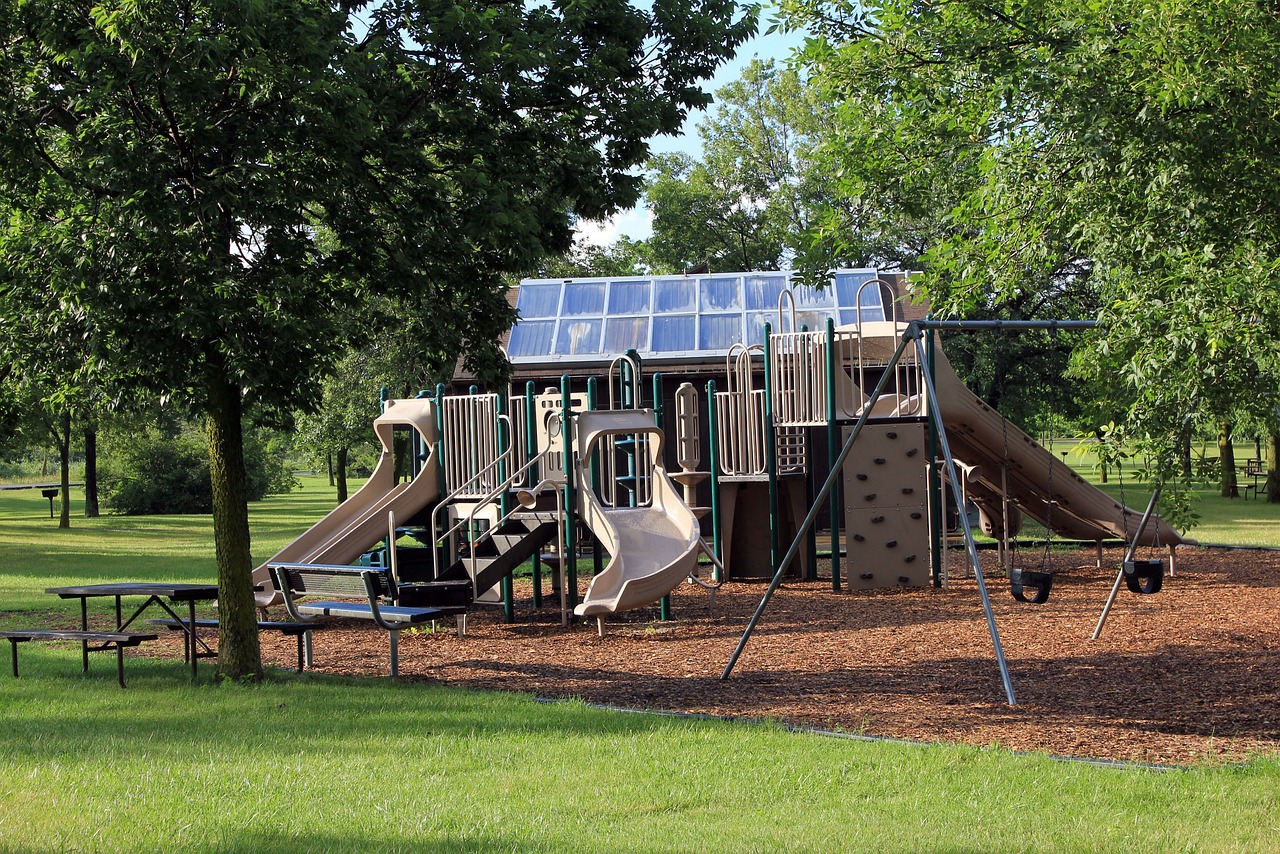
Regular Deep Cleaning Practices
When it comes to maintaining a clean grooming area, are just as crucial as daily routines. Think of it like giving your grooming space a fresh start every so often. Just like you wouldn't want to live in a house that only gets a surface clean, your grooming area deserves the same level of attention. Deep cleaning not only removes accumulated dirt and grime but also ensures that your tools and equipment are in top-notch condition. This practice is essential for the health and safety of both pets and groomers.
So, how often should you engage in this deep cleaning? Establishing a schedule is key. Many professionals recommend setting aside time for deep cleaning on a weekly or monthly basis. This could involve a thorough wipe-down of all surfaces, including countertops, grooming tables, and even the floors. By sticking to a regular schedule, you can prevent the buildup of dirt and bacteria that can lead to health issues.
During these deep cleaning sessions, it's important to focus on the hidden areas that often get overlooked. For instance, the spaces behind equipment, under grooming tables, and even the ventilation systems can harbor dust and allergens. Make it a habit to check these areas and clean them thoroughly. A clean environment not only looks better but also promotes a healthier atmosphere for everyone involved.
Engaging your staff in these deep cleaning practices can also foster a sense of teamwork and shared responsibility. When everyone is involved, it creates a culture of cleanliness that benefits both the pets and the groomers. Consider holding a brief training session to emphasize the importance of deep cleaning and to outline the specific tasks that need to be completed during these sessions. You could even create a checklist to ensure nothing is missed during the cleaning process. Here’s a basic example of what that checklist might look like:
| Task | Frequency | Assigned To |
|---|---|---|
| Wipe down grooming tables | Weekly | Staff Member |
| Clean tools and equipment | Weekly | Staff Member |
| Dust and vacuum the area | Monthly | Staff Member |
| Check and clean ventilation systems | Monthly | Staff Member |
By implementing a structured approach to deep cleaning, you can ensure that your grooming area remains a safe and welcoming space for pets. Remember, a clean environment not only enhances the grooming experience but also reflects the professionalism and care that you provide. So, roll up your sleeves, gather your team, and make deep cleaning a priority!
- How often should I deep clean my grooming area? It's recommended to schedule deep cleaning sessions on a weekly or monthly basis, depending on the volume of work.
- What cleaning products are best for deep cleaning? Always opt for pet-safe disinfectants that effectively eliminate germs while being safe for animals.
- Can I involve my staff in the cleaning process? Absolutely! Engaging your staff fosters teamwork and ensures that everyone is on the same page regarding cleanliness standards.
- What areas should I focus on during deep cleaning? Pay special attention to hidden areas like behind equipment, under tables, and ventilation systems.
Scheduling Deep Cleaning Sessions
Establishing a regular schedule for deep cleaning sessions is a crucial aspect of maintaining a clean grooming area. Think of it as setting a date with cleanliness! Just like you wouldn’t skip your favorite weekly show, you shouldn’t skip your deep cleaning routine. Consistency is key when it comes to fighting dirt and germs. By allocating specific times for these thorough cleanings, you ensure that your grooming space remains in top-notch condition, ready for every furry client that walks through your door.
To create an effective cleaning schedule, consider the following factors:
- Frequency: Depending on the volume of pets you groom, you might want to schedule deep cleaning sessions weekly or bi-weekly. High-traffic areas that see a lot of action may require more frequent attention.
- Time Allocation: Set aside enough time for these sessions. A rushed cleaning job is often an ineffective one. Aim for at least a couple of hours to ensure every nook and cranny is addressed.
- Team Involvement: Involve your staff in these sessions. Assign specific tasks to each team member to make the process more efficient and foster a sense of teamwork.
To help you visualize your cleaning schedule, here’s a simple table that outlines a possible monthly deep cleaning plan:
| Week | Focus Area | Tasks |
|---|---|---|
| 1 | Equipment | Thoroughly clean and sanitize all grooming tools and equipment. |
| 2 | Surfaces | Deep clean all surfaces, including tables, floors, and walls. |
| 3 | Storage | Organize and sanitize storage areas for grooming supplies. |
| 4 | Common Areas | Focus on waiting areas, restrooms, and other common spaces. |
By following a structured schedule, not only do you keep your grooming area pristine, but you also create a routine that your staff can rely on. It’s like the rhythm of a well-conducted orchestra; everyone plays their part in harmony to achieve a common goal: cleanliness. Plus, your clients—both furry and human—will appreciate the effort you put into maintaining a safe and hygienic environment.
Q: How often should I schedule deep cleaning sessions?
A: It depends on the volume of grooming you do, but a good rule of thumb is to schedule them weekly or bi-weekly for high-traffic areas.
Q: What should I include in my deep cleaning sessions?
A: Focus on sanitizing tools, cleaning surfaces, organizing storage, and addressing common areas to ensure a thorough clean.
Q: Can I involve my staff in the cleaning process?
A: Absolutely! Involving your team not only makes the process more efficient but also fosters a sense of teamwork and responsibility.
Q: What cleaning products are safe for pets?
A: Always opt for pet-safe disinfectants that effectively eliminate germs without harming animals or leaving harmful residues.
Involving Staff in Cleanliness Efforts
This article explores essential practices to ensure a clean and hygienic grooming area, emphasizing the importance of cleanliness for both pets and groomers in maintaining health and safety.
A clean grooming area is vital for preventing infections and ensuring the safety of pets. It fosters a healthy environment that promotes the well-being of both animals and groomers. When you think about it, a clean space is like a fresh canvas for an artist; it allows creativity and care to flourish without the chaos of dirt and germs hindering the process.
Establishing a daily cleaning routine helps maintain hygiene. This includes sweeping, disinfecting surfaces, and ensuring all tools are sanitized after each use to prevent cross-contamination. Imagine walking into a grooming area that sparkles; it sets a positive tone for both the groomer and the pets, making the experience more enjoyable.
Regular sanitization of grooming tools is crucial. Learn effective methods for cleaning brushes, clippers, and scissors to ensure they remain free from dirt and bacteria. Think of your tools as extensions of your hands; they need to be just as clean to provide the best care for your furry clients.
Selecting appropriate cleaning products is essential. Opt for pet-safe disinfectants that effectively eliminate germs without harming animals or leaving harmful residues. It's like choosing the right ingredients for a meal; the quality of your cleaning supplies directly affects the health of your grooming environment.
Storing grooming tools correctly is important for maintaining cleanliness. Use designated containers and ensure tools are organized to prevent contamination and loss. A well-organized space is like a well-tuned orchestra; every tool has its place, and everything works harmoniously together.
A clutter-free environment promotes efficiency and safety. Explore strategies for organizing your grooming area to minimize distractions and maintain a clean workspace. Just like a cluttered mind can hinder creativity, a messy grooming area can slow down your workflow and compromise safety.
In addition to daily cleaning, regular deep cleaning is necessary. This involves thorough cleaning of all surfaces, equipment, and the overall grooming space to ensure maximum hygiene. Think of it as giving your grooming area a spa day; it deserves the extra attention to keep it looking and feeling fresh.
Establish a schedule for deep cleaning sessions. Consistency is key in maintaining a pristine grooming area, so plan these sessions weekly or monthly. Just like brushing your teeth daily is essential for oral health, regular deep cleaning is vital for the longevity of your grooming space.
Engaging staff in cleanliness practices fosters a team environment. It’s not just about one person keeping the space clean; it’s a collective effort that can lead to a more efficient and pleasant workplace. Start by training employees on the importance of maintaining hygiene. Make it clear that cleanliness is a shared responsibility, much like a team sport where every player has a role to play.
Here are some effective strategies to involve your staff:
- Regular Training Sessions: Conduct workshops that emphasize the importance of cleanliness and proper techniques for maintaining hygiene.
- Assign Specific Roles: Designate cleaning responsibilities to each staff member to ensure accountability.
- Incentivize Cleanliness: Create a reward system for staff members who consistently uphold cleanliness standards.
By making cleanliness a part of your team culture, you can create an environment where everyone feels invested in the well-being of the pets and the success of the grooming business. After all, a clean space not only reflects professionalism but also enhances the overall experience for both pets and their owners.
Regularly monitoring the cleanliness of your grooming area is essential. Implement checklists and assessments to ensure all cleanliness standards are met consistently.
Q: Why is cleanliness so important in a grooming area?
A: Cleanliness is crucial to prevent infections and ensure the safety of both pets and groomers. A clean environment promotes better health and well-being.
Q: How often should I deep clean my grooming area?
A: It’s recommended to schedule deep cleaning sessions weekly or monthly, depending on the level of activity in your grooming space.
Q: What are the best cleaning products to use?
A: Always opt for pet-safe disinfectants that effectively eliminate germs while being safe for animals.
Q: How can I encourage my staff to maintain cleanliness?
A: Engage your staff in training, assign specific cleaning roles, and create an incentivization system to promote a culture of cleanliness.

Monitoring and Assessing Cleanliness
When it comes to maintaining a clean grooming area, regular monitoring and assessment are crucial. Think of it as a routine health check-up, but for your workspace. Just like you wouldn’t ignore signs of illness in your beloved pet, you shouldn’t overlook the cleanliness of your grooming area. By implementing a structured approach to cleanliness, you can ensure that both pets and groomers are safe from potential health hazards.
One effective method to keep track of cleanliness is to create a checklist that outlines all the necessary tasks. This checklist should cover various aspects, including:
- Sanitization of tools and equipment
- Cleaning of surfaces and floors
- Proper disposal of waste
- Stocking of cleaning supplies
By checking off these tasks daily, you can quickly identify any areas that may need extra attention. Additionally, consider assigning specific responsibilities to your staff, which not only promotes accountability but also fosters teamwork. When everyone is on the same page regarding cleanliness, it becomes a shared goal rather than a solitary task.
Moreover, it’s beneficial to conduct periodic assessments of your grooming area. This could be done weekly or monthly, depending on the volume of clients you serve. During these assessments, take a closer look at areas that might not be covered in your daily routine. For example, are there hidden corners that collect dust? Is the storage area for your tools organized, or is it a chaotic mess? These deep dives can reveal underlying issues that may otherwise go unnoticed.
To make this process even more effective, consider using a
| Date | Area Assessed | Findings | Action Required |
|---|---|---|---|
| 2023-10-01 | Tool Storage | Disorganized, tools mixed | Reorganize and label storage |
| 2023-10-01 | Floor | Dust accumulation in corners | Deep clean corners |
Lastly, don’t forget to involve your clients in the conversation about cleanliness. Encourage them to provide feedback on their experience, which can include their observations about the grooming area. This not only helps you improve your practices but also builds trust with your clientele. After all, a clean grooming area reflects a professional image and can significantly influence customer satisfaction.
Q: How often should I clean my grooming area?
A: Daily cleaning is essential, but a thorough deep cleaning should be scheduled weekly or monthly.
Q: What are the best products for cleaning grooming tools?
A: Look for pet-safe disinfectants that effectively eliminate germs without leaving harmful residues.
Q: How can I involve my staff in maintaining cleanliness?
A: Provide training on hygiene practices and assign specific cleaning responsibilities to foster teamwork.
Q: What should I include in my cleanliness checklist?
A: Include tasks like sanitizing tools, cleaning surfaces, proper waste disposal, and restocking cleaning supplies.
Frequently Asked Questions
- Why is cleanliness important in a grooming area?
Cleanliness is crucial in a grooming area to prevent infections and ensure the safety of pets and groomers. A hygienic environment promotes the well-being of both animals and staff, reducing the risk of illness and ensuring a positive grooming experience.
- What should be included in a daily cleaning routine?
A daily cleaning routine should include sweeping the floor, disinfecting surfaces, and sanitizing all grooming tools after each use. This helps prevent cross-contamination and maintains a hygienic space for grooming pets.
- How often should deep cleaning be performed?
Deep cleaning should be scheduled regularly, ideally on a weekly or monthly basis. This thorough cleaning process ensures that all surfaces, equipment, and the overall grooming area are maintained to the highest hygiene standards.
- What are the best practices for sanitizing grooming tools?
Effective sanitization of grooming tools involves cleaning brushes, clippers, and scissors with pet-safe disinfectants. It's important to follow the manufacturer's instructions for each tool to ensure they are free from dirt and bacteria.
- What types of cleaning products are safe for pets?
When choosing cleaning products, opt for pet-safe disinfectants that effectively eliminate germs without harming animals. Look for products specifically labeled as safe for use around pets to avoid any harmful residues.
- How can I keep my grooming area organized?
To maintain a clutter-free grooming area, use designated containers for tools and supplies. Organizing your workspace minimizes distractions and helps maintain cleanliness, making it easier to focus on grooming tasks.
- How can staff be involved in cleanliness efforts?
Engaging staff in cleanliness practices fosters a team environment. Train employees on the importance of hygiene and involve them in the cleaning process to ensure everyone is committed to maintaining a clean grooming area.
- What tools can I use to monitor cleanliness?
Implementing checklists and assessments is a great way to monitor cleanliness. Regularly review these checklists to ensure all cleanliness standards are consistently met and address any areas that need improvement.


